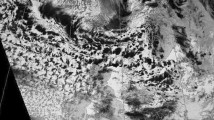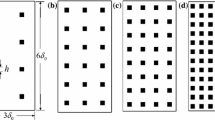Abstract
We describe the results of an experiment focusing on wind speed and momentum fluxes in the atmospheric boundary layer up to 200 m. The measurements were conducted in 1996 at the Cabauw site in the Netherlands. Momentum fluxes are measured using the K-Gill Propeller Vane. Estimates of the roughness length are derived using various techniques from the wind speed and flux measurements, and the observed differences are explained by considering the source area of the meteorological parameters. A clear rough-to-smooth transition is found in the wind speed profiles at Cabauw. The internal boundary layer reaches the lowest k-vane (20 m) only in the south-west direction where the obstacle-free fetch is about 2 km. The internal boundary layer is also reflected in the roughness lengths derived from the wind speed profiles. The lower part of the profile (< 40 m) is not in equilibrium and no reliable roughness analysis can be given. The upper part of the profile can be linked to a large-scale roughness length. Roughness lengths derived from the horizontal wind speed variance and gustiness have large footprints and therefore represent a large-scale average roughness. The drag coefficient is more locally determined but still represents a large-scale roughness length when it is measured above the local internal boundary layer. The roughness length at inhomogeneous sites can therefore be determined best from drag coefficient measurements just above the local internal boundary layers directly, or indirectly from horizontal wind speed variance or gustiness. In addition, the momentum and heat fluxes along the tower are analysed and these show significant variation with height related to stability and possibly surface heterogeneity. It appears that the dimensionless wind speed gradients scale well with local fluxes for the variety of conditions considered, including the unstable cases.
Similar content being viewed by others
References
Beljaars ACM (1982) The derivation of fluxes from profiles in perturbed areas. Boundary-Layer Meteorol 24:35–55
Beljaars ACM (1987a) The influence of sampling and filtering on measured wind gusts. J Atmos Oceanic Technol 4:613–626
Beljaars ACM (1987b) On the memory of wind standard deviation for upstream roughness. Boundary-Layer Meteorol 38:95–101
Beljaars ACM (1988) The measurement of gustiness at routine wind stations – a review. In: WMO-TECO-1988. Leipzig, pp 311–316. WMO/TD-No. 222, also Royal Netherlands Meteorological Institute, Sc. Rep., WR 87-11
Beljaars ACM, Bosveld FC (1997) Cabauw data for the validation of land surface parameterization schemes. J Climate 10:1172–1193
Beljaars ACM, Holtslag AAM (1991) Flux parameterization over land surfaces for atmospheric models. J Appl Meteorol 30:327–341
Beljaars ACM, Schotanus P, Nieuwstadt FTM (1983) Surface layer similarity under nonuniform fetch conditions. J Clim Appl Meteorol 22:1800–1810
Bowen BM (2000) Near-neutral surface layer turbulence at the Boulder atmospheric observatory tower: evidence of increasing vertical turbulence with height. J Appl Meteorol 39:716–724
De Wit AJW, Van der Heijden TGC, Thunnissen HAM (1999) Vervaardiging en nauwkeurigheid van het LGN3 grondgebruiksbestand. DLO-Staring Centrum, Wageningen, 84 pp (in Dutch)
Driedonks AGM, Tennekes H (1984) Entrainment effects in the well-mixed atmospheric boundary layer. Boundary-Layer Meteorol 30:75–105
Dyer AJ (1974) A review of flux-profile relationships. Boundary-Layer Meteorol 7:363–372
Garratt JR (1992) The atmospheric boundary layer. Cambridge University Press, Cambridge, 316 pp
Grant ALM (1991) Surface drag and turbulence over an inhomogeneous land surface. Boundary-Layer Meteorol 56:309–337
Grant ALM, Mason PJ (1990) Observations of the boundary-layer structure over complex terrain. Quart J Roy Meteorol Soc 116:159–186
Højstrup J (1981) A simple model for the adjustment of velocity spectra in unstable conditions downstream of an abrupt change in roughness and heat flux. Boundary-Layer Meteorol 21:341–356
Holtslag AAM (1984) Estimation of diabatic wind speed profiles from near-surface weather observations. Boundary-Layer Meteorol 29:225–250
Holtslag AAM, De Bruin HAR (1988) Applied modelling of the nighttime surface energy balance over land. J Appl Meteorol 27:689–704
Holtslag AAM, Nieuwstadt FTM (1986) Scaling the atmospheric boundary layer. Boundary-Layer Meteorol 36:201–209
Horst TW (1999) The footprint for estimation of atmosphere-surface exchange fluxes by profile techniques. Boundary-Layer Meteorol 90:171–188
Kljun N, Calanca P, Rotach MW, Schmid HP (2004) A simple parameterisation for flux footprint predictions. Boundary-Layer Meteorol 112:503–523
Korrell A, Panofsky HA, Rossi RJ (1982) Wind profiles at the Boulder tower. Boundary-Layer Meteorol 22:295–312
Kustas WP, Brutsaert W (1986) Wind profile constants in a neutral atmospheric boundary layer over complex terrain. Boundary-Layer Meteorol 34:35–54
Monna WAA, Van der Vliet JG (1987) Facilities for research and weather observations on the 213 m tower at Cabauw and remote locations. Scientific Report WR 87-5, Royal Netherlands Meteorological Institute, 27 pp
Nieuwstadt FTM (1978) The computation of the friction velocity u * and the temperature T * from temperature and wind velocity profiles by least-square methods. Boundary-Layer Meteorol 14:235–246
Nieuwstadt FTM (1984) The turbulent structure of the stable, nocturnal boundary layer. J Atmos Sci 41:2202–2216
Pino D, Vilá-Guerau de Arellano J, Duynkerke PG (2003) The contribution of shear to the evolution of a convective boundary layer. J Atmos Sci 60:1913–1926
Rao KS, Wyngaard JC, Coté OR (1974) The structure of the two-dimensional internal boundary layer over a sudden change of surface roughness. J Atmos Sci 31:738–746
Schmid HP, Lloyd CR (1999) Spatial representativeness and the location bias of flux footprints over inhomogeneous areas. Agric Forest Meteorol 93:195–209
Schmid HP, Oke TR (1990) A model to estimate the source area contribution to turbulent exchange in the surface layer over patchy terrain. Quart J Roy Meteorol Soc 116:965–988
Sorbjan Z (1986) On similarity in the atmospheric boundary layer. Boundary-Layer Meteorol 34:377–397
Steeneveld G-J, Holtslag AAM, De Bruin HAR (2005) Fluxes and gradients in the convective surface layer and the possible role of boundary-layer depth and entrainment flux. Boundary-Layer Meteorol 116:237–252
Van der Vliet JG (1998) Elf jaar Cabauw-metingen. Technical Report TR-210, Royal Netherlands Meteorological Institute, 79 pp (In Dutch)
Van Ulden AP (1978) Simple estimates for vertical diffusion from sources near the ground. Atmos Environ 12:2125–2129
Van Ulden AP, Wieringa J (1996) Atmospheric boundary layer research at Cabauw. Boundary-Layer Meteorol 78:39–69
Verkaik JW (1998) Evaluation of the K-Gill propeller vane. J Atmos Oceanic Technol 15:901–915
Verkaik JW (2000) Evaluation of two gustiness models for exposure correction calculations. J Appl Meteorol 39:1613–1626
Vickers D, Mahrt L (1999) Monin-Obukhov similarity theory in the coastal zone. In: Preprints, 13th symp. on boundary layers and turbulence. Amer Meteorol Soc Dallas, TX, pp 407–410
Wessels HRA (1983) Distortion of the wind field by the Cabauw meteorological tower. Scientific Report WR 83-15, Royal Netherlands Meteorological Institute, 34 pp
Wessels HRA (1984) Cabauw meteorological data tapes 1973–1984; description of instrumentation and data processing for the continuous measurements. Scientific Report WR 84-6, Royal Netherlands Meteorological Institute, 23 pp
Wieringa J (1976) An objective exposure correction method for average wind speeds measured at a sheltered location. Quart J Roy Meteorol Soc 102:241–253
Wieringa J (1993) Representative roughness parameters for homogeneous terrain. Boundary-Layer Meteorol 63:323–363
Yumao X, Chaofu Z, Zhongkai L, Wei Z (1997) Turbulent structure and local similarity in the tower layer over the Nanjing area. Boundary-Layer Meteorol 82:1–21
Author information
Authors and Affiliations
Corresponding author
Rights and permissions
About this article
Cite this article
Verkaik, J.W., Holtslag, A.A.M. Wind profiles, momentum fluxes and roughness lengths at Cabauw revisited. Boundary-Layer Meteorol 122, 701–719 (2007). https://doi.org/10.1007/s10546-006-9121-1
Received:
Accepted:
Published:
Issue Date:
DOI: https://doi.org/10.1007/s10546-006-9121-1




